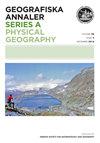Geophysical, topographic and stratigraphic analyses of perialpine kettles and implications for postglacial mire formation
IF 1.8
4区 地球科学
Q3 GEOGRAPHY, PHYSICAL
Geografiska Annaler Series A-Physical Geography
Pub Date : 2018-03-13
DOI:10.1080/04353676.2018.1446638
引用次数: 7
Abstract
ABSTRACT Kettle holes are common ice decay features in formerly glaciated areas. They are highly variable in size and geometry and may form in a variety of glacial and glaciofluvial landforms. Kettle holes are either dry or exist as wetlands or lakes, only rarely transforming into kettle-hole mires. This study investigates Late Pleistocene kettles in the area of the LGM Salzach Glacier Lobe in the North Alpine Foreland. Kettles are here specifically well preserved and concentrate along the former glacier lobe terminus, where they could develop within large elevated areas protected from pro and postglacial sediment redistribution also showing minor anthropogenic overprint. Highest kettle concentrations were observed within a narrow swath along the distal lobe dominated by terminal moraines, ice wastage and outwash deposits, whereas they are almost absent in the centre of the former glacier lobe. Based on a new dataset on regional kettle distribution and a study of comparable wetland environments, we show that kettle lake formation is a specific but rare phenomenon, which is closely related to the preceding dynamics at the glacier lobe and the glacial depositional environment. By applying geophysical surveys (electrical resistivity tomography, ground-penetrating radar), topographic as well as stratigraphic investigations (DEM analysis, core-drilling and radiocarbon dating), we explore the postglacial evolution of the Jackenmoos kettle and propose a modified model of peat formation in kettle-hole mires, mainly as a function of the centripetal growth of a floating mat covering a central subsurface water body.高山周围水壶的地球物理、地形和地层分析及其对冰川后泥沼形成的影响
壶洞是原冰川区常见的冰蚀特征。它们的大小和几何形状变化很大,可能形成各种冰川和冰川河流地貌。壶洞要么干涸,要么以湿地或湖泊的形式存在,很少会变成壶洞泥潭。本文研究了北阿尔卑斯前陆LGM萨尔扎克冰川叶地区晚更新世的水壶。这里的水壶保存得特别好,并集中在前冰川叶末端,在那里它们可以在大型高架地区发展,免受冰川前后沉积物再分布的影响,也显示出轻微的人为重叠。在沿末端冰碛、冰损和冲蚀沉积物为主的远端冰川瓣的狭长地带,观察到最高的壶浓度,而在前冰川瓣的中心几乎没有。基于新的区域壶状湖分布数据和可比湿地环境的研究,表明壶状湖的形成是一种特殊而罕见的现象,它与冰川叶的前期动力学和冰川沉积环境密切相关。通过地球物理调查(电阻率层析成像、探地雷达)、地形和地层学调查(DEM分析、岩心钻探和放射性碳测年),我们探讨了Jackenmoos壶的冰川后演化,并提出了壶孔泥炭形成的修正模型,该模型主要是覆盖在中心地下水体上的浮垫向心生长的函数。
本文章由计算机程序翻译,如有差异,请以英文原文为准。
求助全文
约1分钟内获得全文
求助全文
来源期刊
CiteScore
3.60
自引率
0.00%
发文量
12
审稿时长
>12 weeks
期刊介绍:
Geografiska Annaler: Series A, Physical Geography publishes original research in the field of Physical Geography with special emphasis on cold regions/high latitude, high altitude processes, landforms and environmental change, past, present and future.
The journal primarily promotes dissemination of regular research by publishing research-based articles. The journal also publishes thematic issues where collections of articles around a specific themes are gathered. Such themes are determined by the Editors upon request. Finally the journal wishes to promote knowledge and understanding of topics in Physical Geography, their origin, development and current standing through invited review articles.

 求助内容:
求助内容: 应助结果提醒方式:
应助结果提醒方式:


